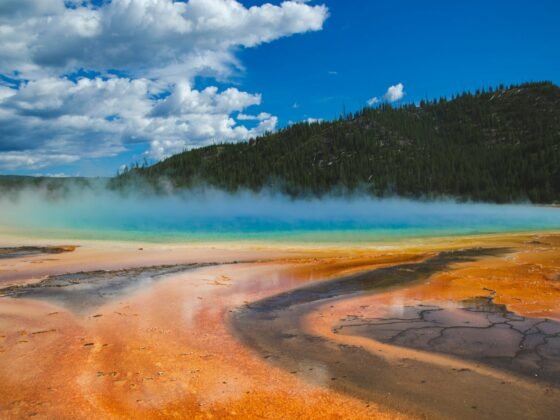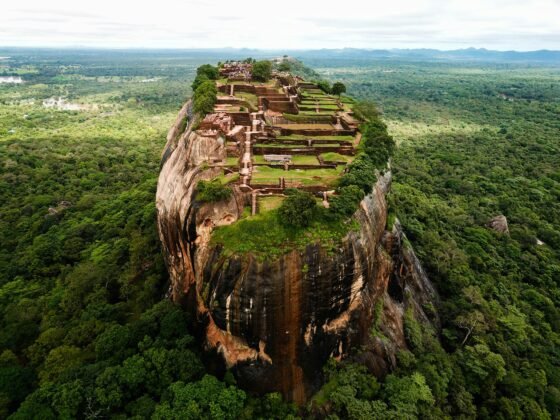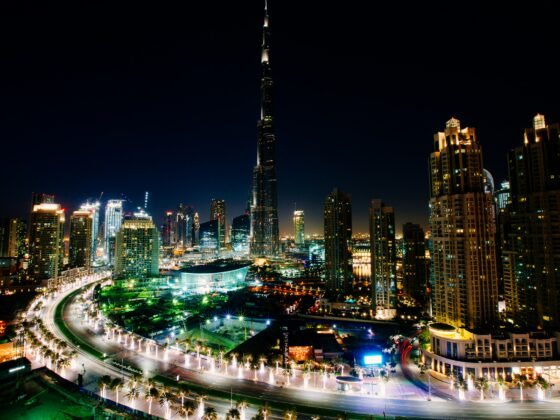Buddhist temples offer a calm and serene atmosphere and whether you’re a Buddhist or not, just witnessing the colourful and ornate surroundings never fails to wow.
China
The East Asian country of China has some 187 million Buddha devotees. For tourists this translates as a wealth of cultural hotspots in the many pagodas, temples and sculptures. And the most famous Chinese Buddhist sculpture has to be the UNESCO listed Giant Buddha at Leshan (pictured above). Located in the Sichuan province, the Mount Emei stone sculpture is the largest in the world – just look at how small the people look in the picture above in comparison to the 71 metre (233 feet) tall seated Maitreya Buddha. Constructed in the Tang Dynasty period of 618–907AD, the majestic Giant Buddha has the rivers flowing at his feet and was fortunately spared damage in the massive 2008 Sichuan earthquake that saw giant pandas escape.
Japan
The second biggest Buddhist population is in Japan which has around 71 million followers, who also often jointly observe Shinto views. And since the 13th century, the cradle of Nichiren Buddhism is attributed to the city of Kamakura. The Great Buddha of Kōtoku-in lies within a larger temple complex and the gigantic bronze Amida statue is a famous icon of Japan. The second largest Buddhist statue in Japan at 13.35 meters (43.8 feet) tall, the deeply weathered Buddhist statue is really striking.
And in case you wondered, the largest bronze Buddha statue is at Tōdai-ji in the city of Nara. Built in 728 AD, the statue depicts Buddha Vairocana which is known in Japanese as Daibutsu.
Thailand
Possibly the most famous Buddhist destination in the world is Thailand which actually has over 40,000 wats (temples) dotted throughout the country. More than 60 million Thai people follow Buddhism with the majority of temples devoted to the Maha Nikaya branch of the faith. The temples are ordered by class and the only structure to sit within the ‘special class’ category is the absolutely captivating Wat Phra Kaew. In English its better known as the Temple of the Emerald Buddha and it sits within Grand Palace complex in central Bangkok. The best way to experience this 18th century wonder up close is to take a skytrain to the Chao Phraya River, then catch one of the many passenger boats that ply their trade along this lively waterway. The Emerald Buddha is actually constructed of jade and the highly revered Thai King changes the statue’s cloak three times a year to bring luck.
Vietnam
The practice of Buddhism was introduced into Vietnam from neighbouring China possibly as early as the 2nd century BC. The Vietnamese respect the Tiantai branch of Buddhism and there are more than 43 million devotees in the country. Most notable Buddhist structures include the But Thap Pagoda in the north, which is attributed as the first center of Buddhism in Vietnam. The Giac Lam Pagoda in the capital city of Saigon features many brass statues of Buddha and the Tran Quoc Pagoda is the oldest in Hanoi.
Myanmar (Burma)
Travellers that make the effort to get to Myanmar are rewarded with a wealth of heritage and culture, not least the abundance of graceful Buddhist monuments and pagodas. The most well-known of these are the sacred Shwedagon Pagoda, Kaba Aye Pagoda, aka the World Peace Pagoda and the Botahtaung Pagoda which translates as the ‘1000 military officers’. The Shwedagon Pagoda is particularly revered as it’s said that its houses stands of hair and relics of Buddha. In total there are 35 million Buddhists in Burma.
Sri Lanka
Around 70% of the population of Sri Lanka follows Theravada Buddhism, which equates to around 14 million people. And as the country recovers from the civil war and the devastating tsunami of 2004, more and more tourists are discovering the rich heritage within the multitude of religious monuments and structures. One of the most striking examples is the massive rock temple devoted to a reclining Buddha monument at Polonnaruwa in north central Sri Lanka. And the most famous example is the Temple of the Tooth, Sri Dalada Maligawa, which, as the name suggests, holds the sacred relic that is said to be the Buddha’s tooth
Cambodia
The Southeast Asian country of Cambodia is home to the most famous Buddhist complex in the world – Angkor Wat. With a following of more than 12 million people in Cambodia, this complex is also the largest religious monument on earth and actually started out as a Hindu temple! Built in the early 12th century by the Khmer King Suryavarman II, it was designed to be his state temple and mausoleum when the day came. Lying just north of Siem Reap, Angkor Wat is a UNESCO World Heritage Site which attracts hundreds of thousands of tourists every year.
Image Credits; 1; Ariel Steiner, 2; Dirk Beyer 3: Tango7174












